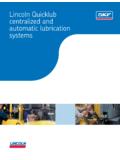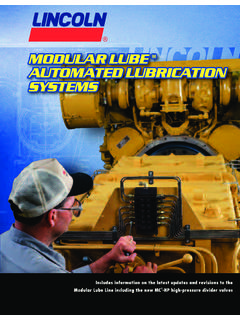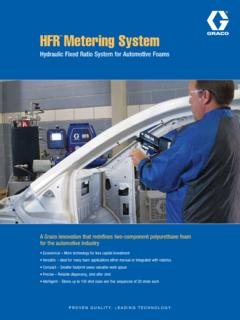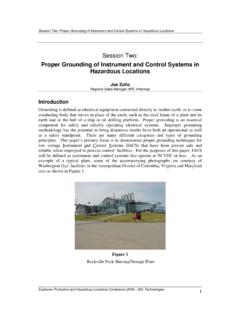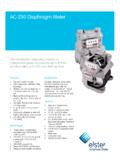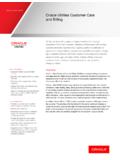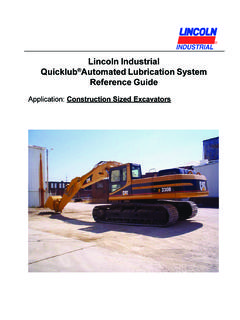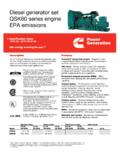Transcription of METERING SIZE PRESS DRYING - globaltechllc.com
1 METERING S IZE PRES S DRYING . By: James M. Rennes, Global Technologies, LLC. Green Bay, WI 54304. USA. ABSTRACT. Today's papermakers face an ever-increasing requirement for the production of sophisticated paper products with a variety of functional surface coatings. The move towards these higher value added products and the recent trend towards on- machine coating operations has in turn brought with it a requirement for advanced DRYING configurations and contactless web handling systems. Typically, this requires the addition of supplemental non-contact DRYING and non-contact web handling equipment. Advances in DRYING and web handling have also brought forth a myriad of new machine configuration possibilities not thought possible with older generation equipment. These possibilities are still emerging and some new layouts have emerged as a direct result of the new technology. This paper will provide an overview of the current state of the art DRYING and web handling strategies being employed on METERING size PRESS applications.
2 Topics will include the discussion of gas IR, air flotation DRYING and hybrid systems which turn and dry the web all in one enclosure arrangement. Other topics will include the application of air turns and web stabilizers in the overall scheme. Each of the DRYING and web handling systems will be described in terms of the operating principles, process advantages and quality enhancement features. Having a thorough understanding of the DRYING process, application requirements, DRYING hardware and some of the quality defects the DRYING process can induce will be beneficial in selecting the right dryer/web handling combination. Key words: gas IR DRYING , air flotation DRYING , steam cylinder DRYING , air turns, web stabilizers, combination systems, integrated air turn DRYING systems, DRYING configurations INTRODUCTION. The recent advances in METERING size PRESS (MSP) technology have resulted in a way for mills to improve paper quality with minimum investment costs.
3 To provide the quality required, coated paper manufacturers have had to undertake a comprehensive review of existing on-machine sizing/coating facilities and corresponding DRYING and web handling systems. It is well known that coating quality is directly affected by the structure and composition of the base sheet, the coating formulation, the method of application, and the details of the DRYING process. Additionally it is common knowledge that an improper DRYING strategy can very quickly ruin a potentially good surface coating even though the coating technology is correct. To avoid this potential problem, it is important to have a clear understanding of the DRYING and web handling technology available and how to apply these systems in typical MSP applications. Today's MSP applications will typically have a combined DRYING arrangement to take advantage of the benefits each system has to offer. The following is a list of the web handling and DRYING systems typically employed in DRYING coated paper in MSP applications: Air Turns (non-heated and heated).
4 Web Stabilizers Gas IR Systems Air Flotation Dryers (Conventional and High Performance). Combination Gas IR / Air Flotation DRYING (Hybrid Systems). Integrated DRYING systems which turn and dry the coated web It is important to realize that when the respective DRYING and web handling equipment are brought together in the tight space configurations prevalent in existing machine configurations, new and innovative layouts need to be considered. DRYING Paper Coatings One of the first requirements for DRYING coated paper is to dry the newly applied coating without the wet surface having an opportunity to be picked off or displaced by physical contact with a roll surface. Secondly, the DRYING must be done in such a manner so that coating quality problems are not developed (binder migration) during the DRYING process. Surface deposits of binder can influence the printing process by affecting ink receptivity causing print mottle.
5 The most critical period during the DRYING process starts when the coating is applied and ends when the coating reaches the gel or immobilization point. Typically this is defined as the point in the DRYING process where the coating binder movement drops off to a harmless level regardless of the DRYING rate applied. This occurs when the binder becomes physically trapped between the particles of pigment and becomes immobilized or consolidated. Actual applications have shown that coating immobilization is not a discrete event but occurs over a range of average solids contents. Prior to the entry of the first dryer, the entire surface of the coated paper web is wet and available for evaporation. The DRYING process will initially remove water from the free liquid on the coating surface and as long as the surface water remains continuous, all the evaporation will occur from that area. Once this surface layer has evaporated, the air/liquid interfaces will move down in the coating pores with surface tension forces drawing water by capillary flow from the spaces between the pigment particles in the coating to replace that removed by evaporation.
6 As more water is removed, consolidation or gelling of the coating solids will occur at the surface of the coating towards the base sheet. As the DRYING process continues the water from within the coating layer will no longer replenish the surface which results in the showing of dry coating pores. At this point, the coating solids down through the coating will be consolidated and the coating binder wherever it may be, will be locked in place. Figure 1 illustrates the DRYING process. The DRYING process is opposite of the dewatering process since it DRYING with Sheet Dewatering moves binder towards the base sheet. Manipulating the DRYING process will allow the organized Water Pigment movement of moisture to the coating surface in a O riginal Wet Surfa ce Binder fashion which insures coating quality. Coating Optimizing coating quality requires a delicate DRYING balance. DRYING rates, coating application Drained Fiber Water temperature, base sheet temperatures and distance to Fiber the DRYING system all must be managed to ensure the pore optimum sheet quality.
7 DRYING the coating too Fiber s aggressively can lead to potentially harmful binder migration. DRYING too slowly can lead to potentially Fig. 1. harmful dewatering with corresponding fiber swelling. Therefore, it is important that care be taken so as to apply each type of DRYING properly and in the proper sequence at the necessary intensity. Solving the Non-Contact Turning Problems Air Typical Coater Layout Turns Figure 2 is an illustration of a typical size PRESS After Dryer Section arrangement using conventional chill or spreader rolls to turn the sized web into the steam cylinder section. Surface sizing rewets the sheet causing fiber swelling and corresponding sheet expansion leading to size PRESS troublesome wrinkles. The most commonly used device to compensate for sheet expansion is the curved spreader (bowed) roll. Spreader Roll Contact turning spreader rolls have been known to cause picking problems and was in some respects a Fig.
8 2 limiting factor in the development of new coating techniques employed in MSP technology. The development and application of METERING size PRESS technology allowed mills to begin applying higher solids coatings at higher speeds. Consequently problems were encountered with wet coating picking on the turning roll(s). and the lack of DRYING capabilities to set the coating prior to the introduction to the steam cylinders. To address the quality problems being experienced required the development of non-contact turning in conjunction with determining how additional DRYING could be incorporated into the already tight space following the MSP. The tight configurations of on-machine arrangements provided machine builders some difficult problems to solve. Air turns were initially developed in the 70's and helped solve a wide range of problems of contactless Typical Air Turn Arrangement web handling after coating and size PRESS applications.
9 In essence this product is a circular air flotation web handling system designed to allow a change of web direction without any surface contact. A typical air After turn arrangement is shown in Figure 3. DRYING METERING Modern day air turns employ the proven performance size PRESS of twin slot pressure pad flotation air bars which have seen extensive use in flotation DRYING systems in off machine coating operations. The air bars provide a stable cushion of air extending across the full width of Air Turn the unit. These cushions provide full support to the sheet such that the flotation height is the same in the Fig. 3. center of the sheet as it is at the edge of the sheet irrespective of the width of the sheet. Typical Air Bar Pressure Pad In operation, these air bars generate supporting air cushion between the surface of the air bar and the coated web being processed as shown in Figure 4. The very best designs utilize regions of high and low pressure to bring about a perfectly symmetrical profile 'T' 'T'.
10 Which in turn results in high clearance and firm web stability. Performance is directly related to the special Pc 'C'. aerodynamic effects brought about as the air exits from the slot outlets. The forces generated in the air Cushion (Pc). flotation cushion need to be high in magnitude since these are used to effectively offset the force generated Fig. 4. by the tension in the web. The modern air turn system embodies these features and benefits by using these Typical Air Turn Air Bar Arrangement same air bars arranged in a curve path as depicted in 'T' 'T'. Figure 5. Air Feed Duct The flow channel areas provided between the air bars control the escape of air from the air cushion at the end of the air bars which provides additional support and minimizes the fan power required to operate the system. The flow of air throughout the area between air bar channels also imparts a smoothing effect to the sheet reducing wrinkles and creases.
